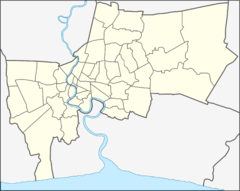Kian Un Keng Shrine
 From Wikipedia the free encyclopedia
From Wikipedia the free encyclopedia
| Kian Un Keng Shrine | |
|---|---|
ศาลเจ้าเกียนอันเกง | |
 Kian Un Keng Shrine frontage | |
| Religion | |
| Affiliation | Buddhism |
| Sect | Mahāyāna |
| Region | Central |
| Deity | Guanyin |
| Location | |
| Location | 582 Arun Amarin Rd, Wat Kanlaya, Thon Buri, Bangkok |
| Country | Thailand |
| Geographic coordinates | 13°45′23.83″N 100°29′33.17″E / 13.7566194°N 100.4925472°E |
| Architecture | |
| Type | Joss house |
| Style | Chinese |
| Founder | Hokkienese |
Kian Un Keng Shrine or spelled Kuan An Keng Shrine (Thai: ศาลเจ้าเกียนอันเกง; Chinese: 建安宮; pinyin: Jiàn'ān gōng), known internationally as Guanyin Shrine (ศาลเจ้าแม่กวนอิม), is an ancient Chinese joss house in Bangkok, located on the western bank of Chao Phraya River, Wat Kanlaya Subdistrict, Thon Buri District, Thonburi side in the area of Kudi Chin community close to other places of worship including Wat Prayurawongsawat, Wat Kalayanamitr and Santa Cruz Church with Bang Luang Mosque.
This shrine is a Hokkien temple. It's one of the oldest shrines in Thonburi and Thailand by King Taksin and brought the Goddess Guanyin statue to be enshrined here. The Guanyin Bodhisattva is different from other shrines because mostly the Guanyin in other shrines are in standing position, but here the Guanyin is in sitting position. The Guanyin statue is made of wood carved and coated with gold. There are also murals and paintings of the classical novel Romance of Three Kingdoms, including dolls decorated on the wall decorations for visiting and worshipping.

The artist Fua Haripitak praised the artistic values of both painting and wood carving objects here. He decided that the door keepers paintings are showcases of different artists. Even the door, each side of it was created by different artisans. Both of them are famous at that time.
Its name is assumed to be the origin of the name Kudi Chin, which means "Chinese monk's dwelling".[1] [2] [3]
Originally, the shrine was divided into two shrines, Lord Guan and Chor Su Kong shrines. Later, both were in disrepair during the reign of King Taksin. During the reign of King Rama III, the Hokkienese therefore demolished both shrines and rebuilt with Chinese courtyard architecture along with brought the Guanyin statue enshrined instead since then. Its name meaning "building that create peace and tranquility for the Hokkienese".[4]
It is currently under the care of Simasatian (or Shēn, 沈) and Tantiwetchakun (or Chen, 陳) families, which are their offspring.
The shrine received the ASA Architectural Conservation Award in 2008.
Moreover, during the annually Vegetarian Festival this shrine will have a special event unlike other shrines. That is a ceremony similar to Loi Krathong in order change one's bad fortune for the people who make merit here. Including a boat trip to visit another shrine on opposite side of the river, Chó-su-kong Shrine in Talat Noi, Chinatown.[5]
See more[edit]
- Thian Fah Foundation– Another Guanyin shrine in Phra Nakhon side, Bangkok
References[edit]
- ^ Rungchawannon, Monsicha (2012-07-06). "เกียงอันเกง : เมื่อรักษ์และศรัทธามาบรรจบ" [Kian Un Keng : When conservation and faith meet]. Sarakadee Magazine (in Thai).
- ^ Num rattana (2010-05-03). "พาไหว้สักการะ ศาลเจ้าเกียนอันเกง ของชาวฮกเกี้ยน" [Pay homage Kian Un Keng Shrine of the Hokkienese]. Pantip.com (in Thai).
- ^ "จับเข่าเล่าประวัติศาสตร์" [Historical conversation]. Chub khao lao prawattisart (in Thai). 2017-08-09.
- ^ Charoensiriphan, Pimphaya (2019-01-15). "a day experience ชวนเดินเท้าสำรวจชุมชนเก่าย่านฝั่งธนในทริปเดินดีที่กุฎีจีน" [a day experience, inviting to walk on foot to explore the old community in Thonburi neighbourhood on a good trip at Kudi Chin]. a day magazine (in Thai). Retrieved 2019-10-07.
- ^ "ไหว้เสริมดวงช่วงกินเจ มีมากว่า 200 ปีต้องมีดี" [Pay respect to the gods to increase fortune during the Vegetarian Festival for more than 200 years, must have good]. Thairath (in Thai). 2019-09-30. Retrieved 2019-09-30.
